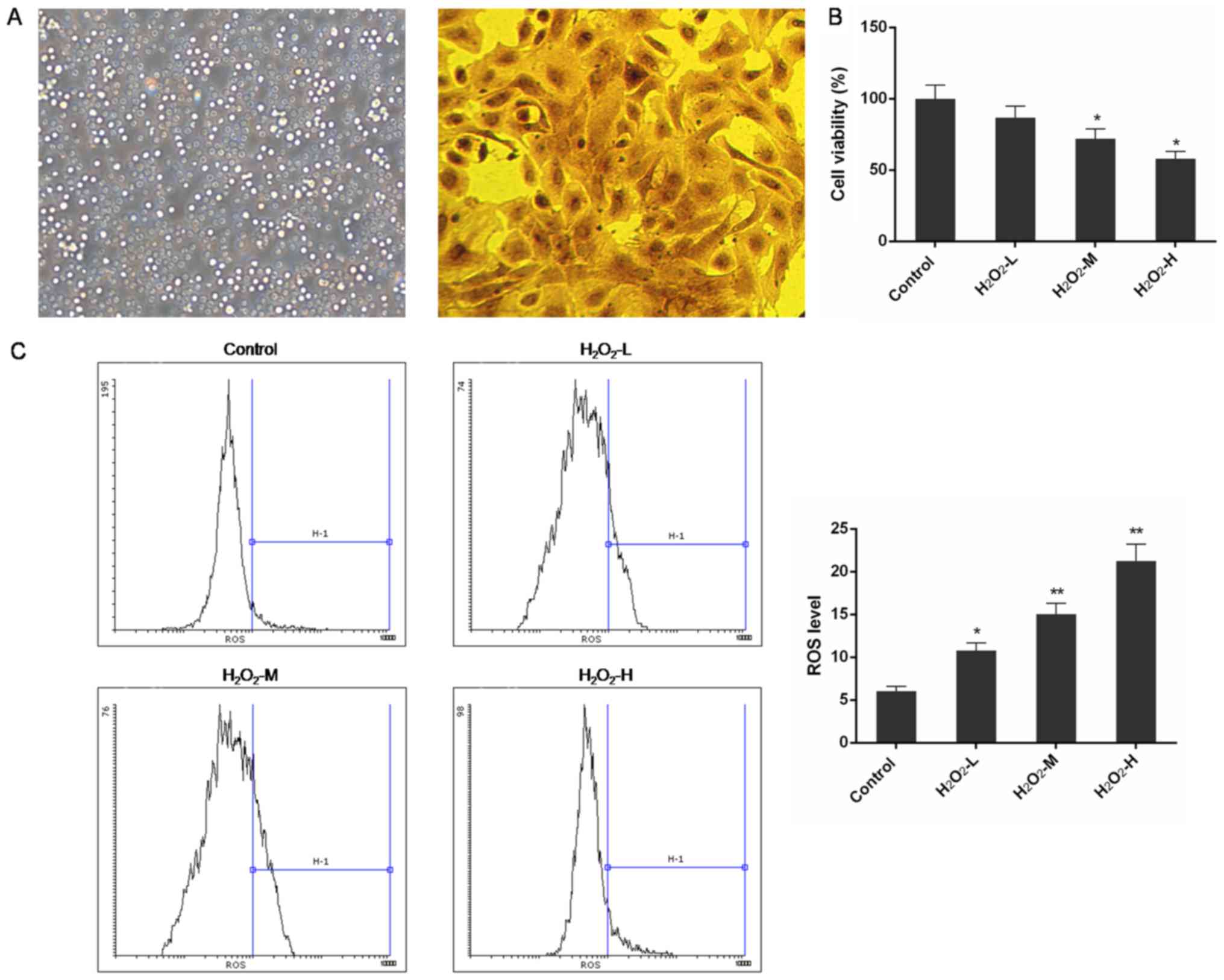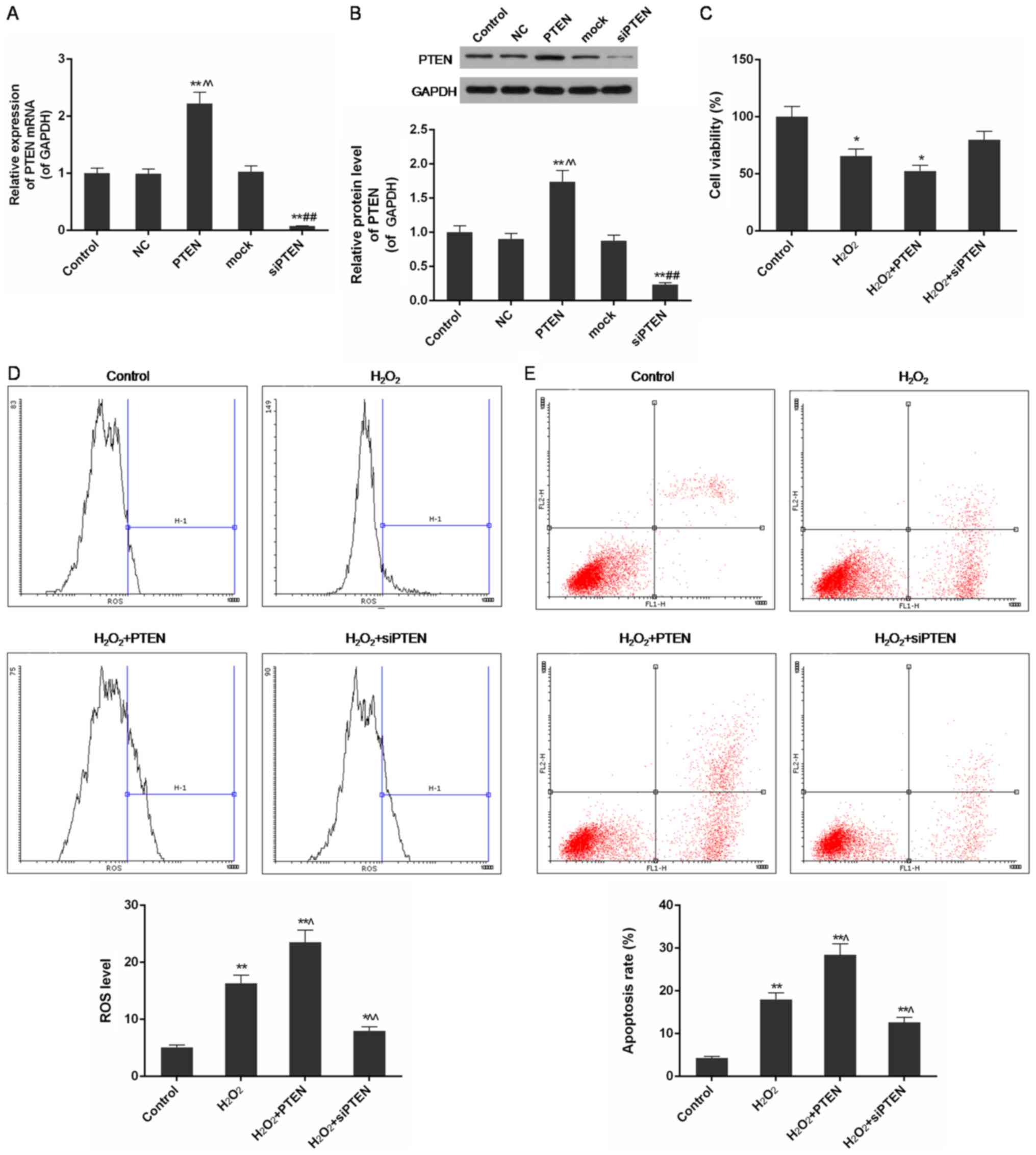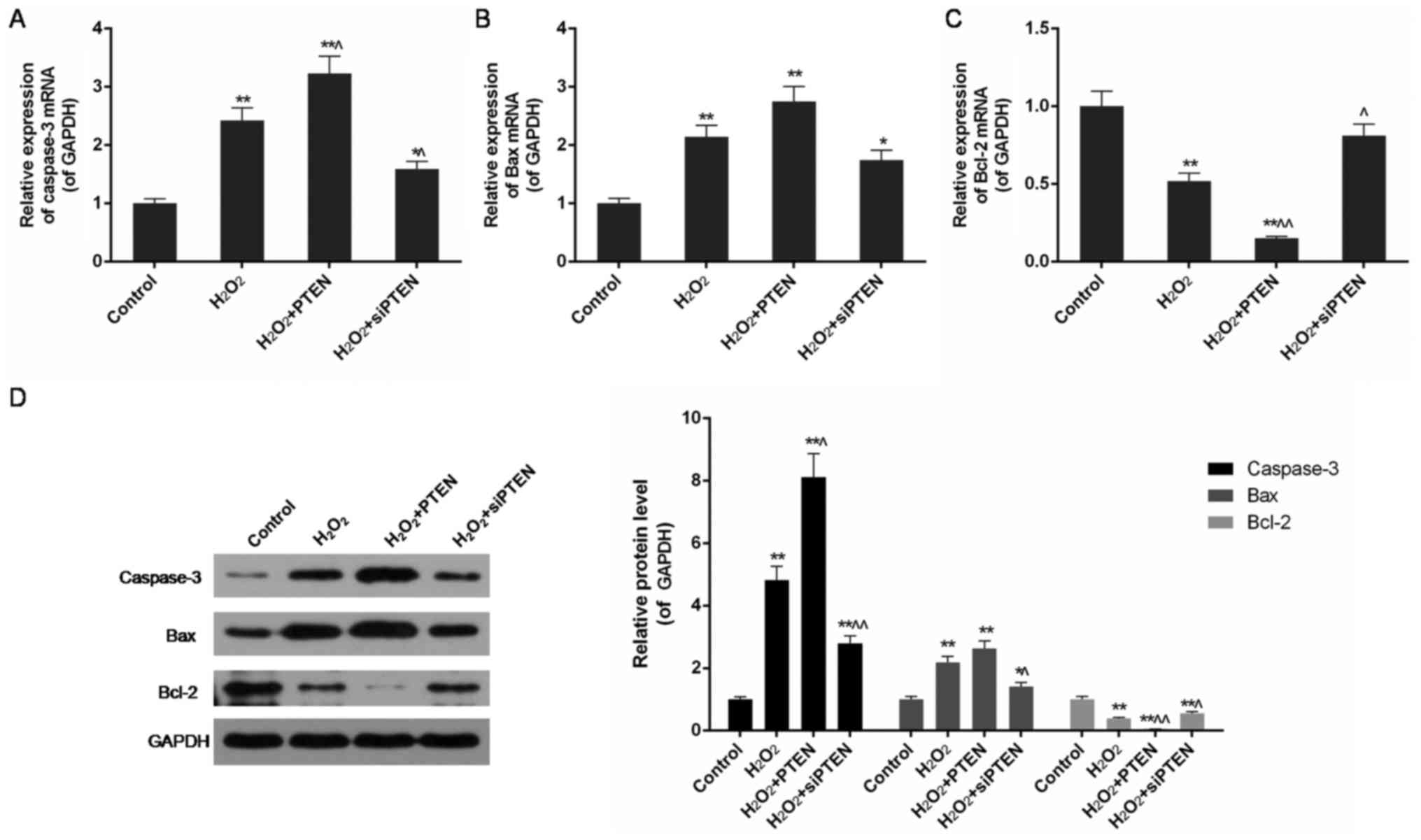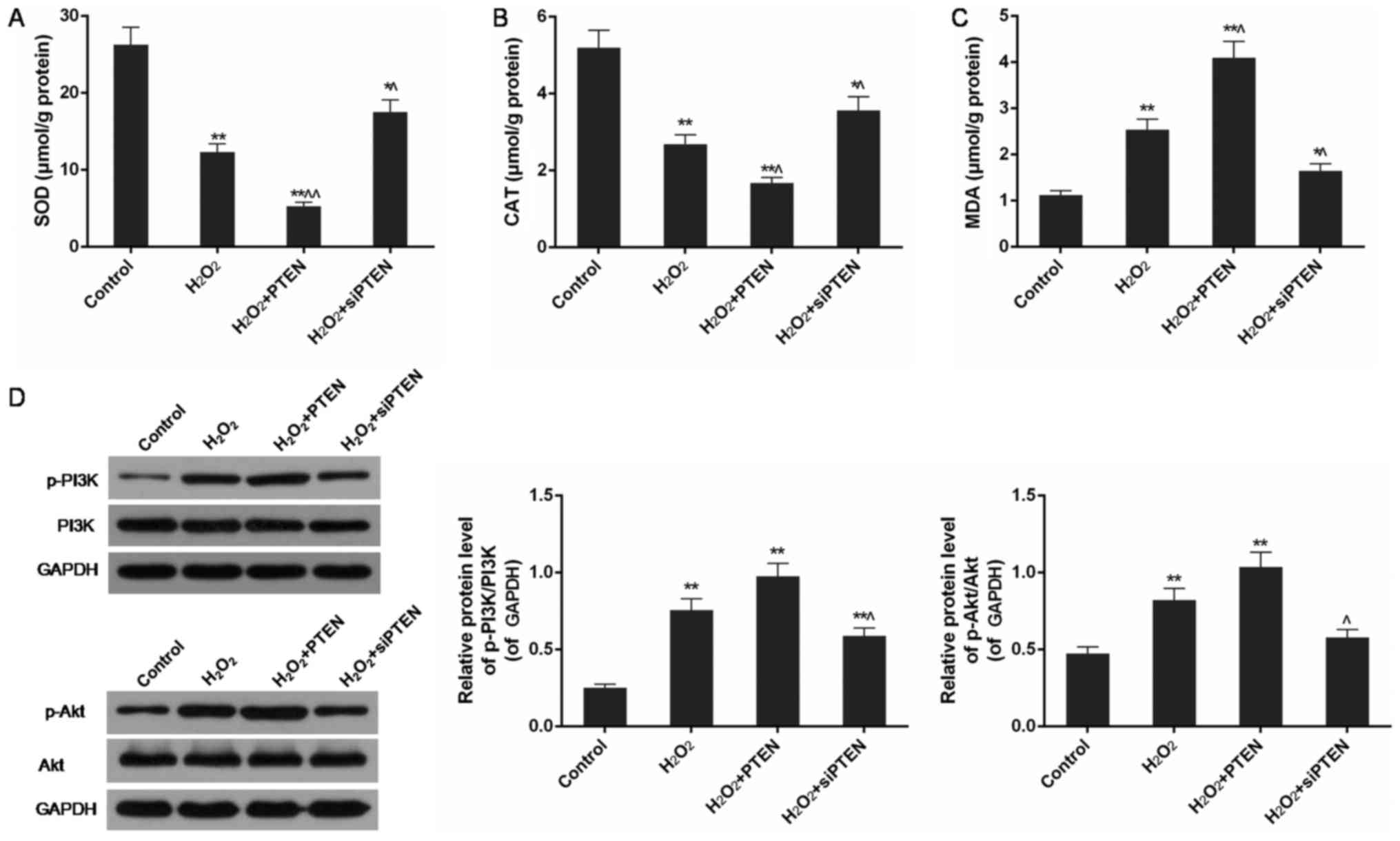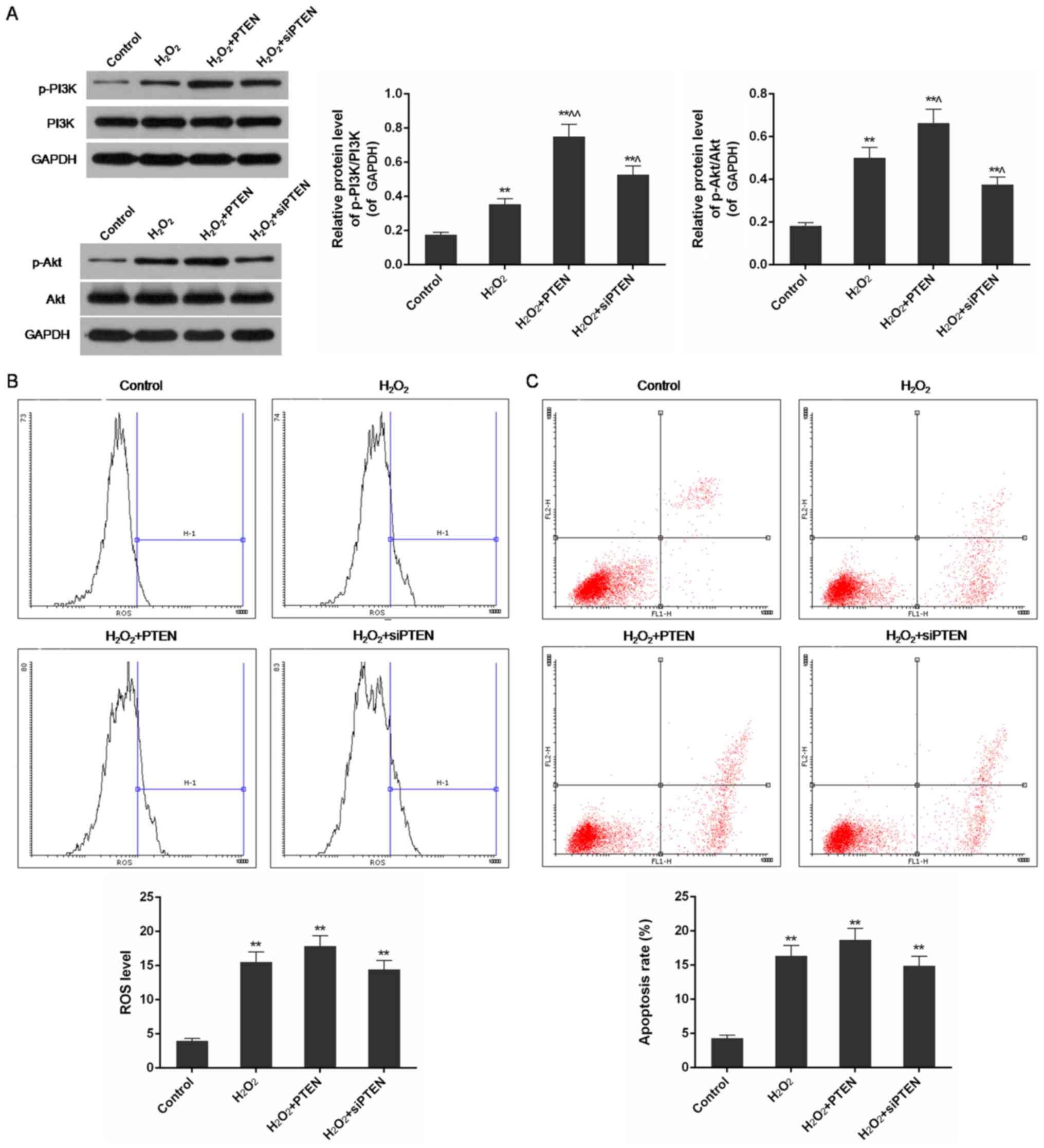PTEN promotes apoptosis of H2O2‑injured rat nasal epithelial cells through PI3K/Akt and other pathways
- Authors:
- Published online on: October 26, 2017 https://doi.org/10.3892/mmr.2017.7912
- Pages: 571-579
Abstract
Introduction
Chronic rhinosinusitis (CRS) is clinically defined as chronic inflammation of the nasal cavity and paranasal sinus lasting over 12 weeks, including chronic rhinosinusitis with nasal polyps (CRSwNP) and chronic rhinosinusitis without nasal polyps (CRSsNP). Nasal mucosal inflammatory lesion has high heterogeneity and is formed in a multi-step process caused by multiple factors (1). Tissue remodeling is a dynamic process of organic damage repair resulting from long-term inflammatory stimulation (2). Different types of CRS have different manifestations of mucous tissue remodeling: CRSwNP mainly appears as hyperplasia of goblet cells, extracellular matrix (ECM) proteinosis, and edema, while CRSsNP primarily manifests as exuviation, collagenous fiber precipitation, and submucous fibrosis (3,4). Factors that influence the generation and degradation of ECM, such as (transforming growth factor) TGF, oxidative stress, matrix metalloproteinases (MMPs), tissue inhibitor of metalloproteinase, and vascular endothelial growth factor (VEGF), can have effects on tissue remodeling, although the mechanisms of network regulation by these factors is still unclear (5).
Excessive generation of reactive oxygen species (ROS) in cells or tissues results from noxious stimulation by atmospheric pollution, smoke, drugs and trauma can lead to disequilibrium of oxidant and antioxidant systems, resulting in tissue damage, which in turn causes additional oxidative stress (6). Based on previous studies, oxidative stress is likely to play an important role in the generation and development processes of nasal polyps (7–9). Cekin et al discovered that the (malondialdehyde) MDA level was increased in nasal polyps, while nitric oxide and (superoxide dismutase) SOD levels were reduced; this findingindicates a metabolic disorder involving free radicals (7). Bozkus et al found that oxidative stress parameters in the blood and nasal polyps of patients were higher than those of people without the disease, and the level of oxidative stress was positively correlated with patient age (8). Okur et al reported that neutrophil granulocytes of patients with nasal polyp could generate ROS, which is one means of releasing ROS by nasal polyps (9).
Phosphoinositide 3-kinase (PI3K) is a bridge to link extracellular stimulating factors and intracellular response effects and possesses activities of serine/threonine kinase and phosphatidylinositol kinase. Akt, the downstream effector protein of PI3K, is a serine protease. Unphosphorylated Akt lacks biological activity. Once it is phosphorylated, Akt (p-Akt) is able to regulate cell growth, apoptosis, adhesion, migration, infiltration, and metabolism through numerous pathways (10). phosphatase and tensin homolog gene (PTEN) is the first discovered cancer suppressor gene with bispecific phosphatase activity (11). PTEN is known to inhibit the activity of PI3K, which then affects the phosphorylation of Akt (12). The PI3K/PTEN/Akt signal pathway has been demonstrated to play a role in a variety of tumors including hematological neoplasms, liver cancer, intestinal cancer, osteosarcoma, and lymphoma (13–16). This pathway was recently found to be closely related to chronic inflammatory diseases and autoimmune diseases such as asthma (17).
However, it remains uncertain whether the PI3K/PTEN/Akt pathway is associated with CRS. In this study, we investigated the relationship between imbalanced expression of PTEN and the components of the PI3K/Akt signaling pathway in rat nasal epithelial cells. H2O2 was applied to increase ROS levels to simulate oxidative stress in CRS.
Materials and methods
Cell grouping
Rat nasal epithelial cells were obtained from Nanjing Cobioer Biotechnology Co., Ltd. (Jiangsu, China). Cells were randomly divided into four groups: control, H2O2, H2O2+PTEN and H2O2+siPTEN group. In H2O2+PTEN and H2O2+siPTEN group, cells were respectively infected by plasmids with PTEN gene and plasmids with silenced PTEN gene. Recombinant plasmids were also purchased from Nanjing Cobioer Biotechnology Co., Ltd. Cells in H2O2, H2O2+PTEN and H2O2+siPTEN group were treated by 50 µmol/l of H2O2 (Shanghai Macklin Biochemical Co., Ltd., Shanghai, China) for 3 h. The appropriate concentration of H2O2 was selected from 20, 50 and 80 µmol/l by detecting cell viability through CCK-8 assay.
Cell transfection
Cells in logarithmic growth phase were seeded into a 6-well plate and cultured for 24 h. Recombinant plasmids expressing either the PTEN gene or the silenced PTEN gene were transfected into cells using Lipofectamine LTX according to the manufacturer's instructions (Invitrogen; Thermo Fisher Scientific, Inc., Waltham, MA, USA). Two micrograms of pIRES2-ZsGreen1-vector (Nanjing Vazyme Biotechnology Co., Ltd., Jiangsu, China), 5 µl of Lipofectamine LTX and 250 µl Opti-MEM (Shanghai Yeasen Biotechnology Co., Ltd., Shanghai, China) were well prepared, mixed, and then incubated at room temperature for 25 min. Subsequently, 500 µl of the mixture was added into each well of a 6-well plate with RPMI-1640 medium. After 48 h culture, the transfected cells were harvested for the indicated experiments. Western blot was used to detect the expression of PTEN to assess the transfection efficiency.
CCK-8 assay
Cell viability in each group was detected through using CCK-8 kit (Shanghai Yeasen Biotechnology Co., Ltd.). Cells were grouped, and seeded into 96-well plates at amount of 100 µl/well, and then incubated at 37°C in 5% CO2 incubator for 4 h. After added with 10 µl CCK reagent to each well, cells were putted into 5% CO2 incubator at 37°C for 1–4 h. Optical density (OD) value of each group was observed at 450 nm by a spectrophotometer (Sigma-Aldrich; Merck KGaA, Darmstadt, Germany).
Flow cytometry (FCM)
Cells in logarithmic phase were collected and seeded into 6-well plates. Cells were digested by EDTA free trypsin, stained with Annexin V-FITC and propidium iodide (all from Shanghai Yeasen Biotechnology Co., Ltd.), and incubated in dark place for 15 min at room temperature afterwards. Cell cycle and apoptosis rate of each group was detected by EPICS XL-MCL FCM (Beckman Coulter, Inc., Brea, CA, USA) with excitation wavelength 488 nm and emission wavelength 530 nm.
ELISA
The levels of SOD and MDA were measured by applying quantitative test kits (Shanghai Lanpai Biotechnology Co., Ltd., Shanghai, China). Cells were divided into control, H2O2, H2O2+PTEN and H2O2+siPTEN groups. Detection was conducted according to the manufacturer's instructions. OD values were read at 420 nm on a spectrophotometer (Sigma-Aldrich; Merck KGaA).
qPCR
Expression levels of PTEN, caspase-3, Bax and Bcl-2 mRNA were detected by means of qPCR. Cells were seeded into 6-well plates at a density of 2×106 cells/well. Total RNA were extracted with TRIzol (Thermo Fisher Scientific, Inc.) according to the manufacture's instructions. Concentration of extracted RNA was read through a UV spectrophotometer (Thermo Fisher Scientific, Inc.). cDNA were synthesized by reverse transcription. Reduced glyceraldehyde-phosphate dehydrogenase (GAPDH) was applied as the internal control to monitor the efficiency of qPCR. All primers in this study were designed by Sangon Biotech Co., Ltd. (Shanghai, China). The specific primer sequences for each gene were listed as the follows: 5′ACC AGG ACC AGA GGA AAC CT3′ and 5′TTT GTC AGG GTG AGC ACA AGA3′ for PTEN (product: 126 bp); 5′ACC GCA CCC GGT TAC TAT TC3′ and 5′CAA ATT CCG TGG CCA CCT TC3′ for caspase-3 (product: 148 bp); 5′TGG CGA TGA ACT GGA CAA CA3′ and 5′CAC GGA AGA AGA CCT CTC GG3′ for Bax (product: 86 bp); 5′AGC ATG CGA CCT CTG TTT GA3′ and 5′TCA CTT GTG GCC CAG GTA TG3′ for Bcl-2 (product: 108 bp) and 5′GGC TCA TGA CCA CAG TCC AT3′ and 5′ACA TTG GGG GTA GGA ACA CG3′ for GAPDH (product: 202 bp). Each reaction was run in triplicate.
Western blot
Cells were seeded in 6-well plates at a density of 2×106 cells/well, and grouped. Cells were harvested and washed twice with PBS, protein lysed in ice-cold radio immunoprecipitation assay buffer (Guangzhou Whiga Technology Co., Ltd., Guangdong, China) with freshly mixed 0.01% protease inhibitor phenylmethanesulfonyl fluoride (Beijign O'BioLab Technology Co., Ltd., Beijing, China), then incubated for 30 min on ice. Cell lysis was centrifuged at 10,000 × g for 5 min at 4°C, collected supernatants containing 20–30 µg of protein were run on 10% sodium dodecyl sulfate-polyacrylamide gel electrophoresis gel and electrophoretically transferred to a nitrocellulose membrane (Merck KGaA). Protein expression level of PTEN, caspase-3, Bax, Bcl-2, p-PI3K, PI3K, p-Akt and Akt were detected. GAPDH monoclonal antibody was used to estimate protein loading. Blots were visualized via an enhanced chemiluminescence (Thermo Fisher Scientific, Inc.).
Statistical analysis
Data were expressed as mean ± SD. Differences among groups were evaluated through variance analysis and Student's t-test. Statistical significance was defined as P<0.05 or P<0.01.
Results
Rat nasal epithelial cells were successfully identified
The in vitro observation under an inverted microscope showed that after 24-h culture in serum medium, a majority of rat nasal epithelial cells grew as single cells adhering to the plate and were round or irregular in shape (Fig. 1A). Cell nuclei formed oval shapes, and the cell body was irregularly shaped. Cells were positive for (diaminobenzidine) DAB, which was detected by immunocytochemical staining with an anticytokeratin 19 antibody (95% purity).
H2O2 treatment decreased cell viability and increased ROS level
The CCK-8 assay indicated that the viability of rat nasal epithelial cells was significantly reduced by H2O2 treatment. H2O2 affected cell proliferation in a concentration-dependent manner and the differences were significant in the H2O2-M (50 µM) and H2O2-H (80 µM) groups when compared with normal control cells (P<0.05) (Fig. 1B). Additionally, the ROS levels in H2O2-treated groups were markedly enhanced and the effect was in a concentration-depended manner (P<0.05 or P<0.01) (Fig. 1C).
The expression of PTEN was upregulated in cells transfected with plasmids containing the PTEN gene and inhibited in cells transfected with siRNA against the PTEN gene
The expression of PTEN in each experimental condition was quantified by qPCR and western blot analysis. In NC and mock-transfected groups, which were transfected with empty plasmids, the mRNA and protein levels of PTEN were similar to the control group. In the PTEN-transfected group, PTEN mRNA and protein were both found to be overexpressed compared with the control group (P<0.01). In contrast, in cells transfected with siRNA against the PTEN gene, the expression of both PTEN mRNA and protein was substantially inhibited (P<0.01) (Fig. 2A and B).
PTEN levels correlated with reduced cell viability and increased ROS level and apoptosis rate in H2O2-injured cells
Using the CCK-8 assay, we found that cell viability and proliferation were decreased by H2O2 treatment and further inhibited in PTEN overexpressing cells, but the injury was improved in the PTEN silenced group (P<0.05) (Fig. 2C). Through FCM analysis, ROS levels in the H2O2-treated group were found to be increased compared with control cells (P<0.01). The level of ROS was further increased in the H2O2+PTEN group, but was inhibited in the H2O2+siPTEN group compared with the group treated with only H2O2 (P<0.05 or P<0.01) (Fig. 2D). H2O2 treatment significantly increased apoptosis, and the rate was further increased in the H2O2-PTEN group but was decreased in the H2O2-siPTEN group (P<0.05 or P<0.01) (Fig. 2E).
PTEN upregulated the expression of caspase-3 and Bax in H2O2-injured cells
In the H2O2-treated group, in agreement with the increased apoptosis rate described above, high expression of caspase-3 and Bax was also detected by qPCR and western blot analysis (P<0.01). In PTEN overexpressing cells, the expression of caspase-3 and Bax was further upregulated, while that of Bcl-2 was significantly reduced compared with the H2O2-treated group (P<0.05 or P<0.01). In contrast, disrupting the expression of the PTEN gene downregulated the expression of caspase-3 and Bax but upregulated Bax following H2O2-induced injury (P<0.05 or P<0.01) (Fig. 3).
PTEN decreased SOD and catalase (CAT) levels and increased MDA content in H2O2-injured cells
Using an ELISA-based assay, a remarkable decrease of SOD and CAT levels and a significant increase of MDA were observed in H2O2-treated cells, compared with the control group (P<0.01). Compared with the H2O2-treated group, overexpression of PTEN in the H2O2-PTEN treated group significantly reduced the level of SOD and CAT but increased MDA, whereas inhibition of PTEN expression in the H2O2-siPTEN group increased SOD and CAT levels and reduced MDA in H2O2-injured cells (P<0.05 or P<0.01) (Fig. 4A-C).
PTEN promoted phosphorylation of PI3K and Akt in H2O2-injured cells
Western blot analysis showed that the levels of phosphorylated PI3K and Akt were significantly increased in H2O2-injured cells in comparison with control cells (P<0.01). Overexpression of PTEN in the H2O2-PTEN group slightly promoted the increase of p-PI3K/PI3K and p-Akt/Akt ratios. In contrast, silencing of the PTEN gene inhibited the activation of PI3K and Akt in H2O2-injured cells compared with the H2O2-treatedgroup (P<0.05) (Fig. 4D).
PTEN promoted activation of PI3K and Akt even when the PI3K/Akt pathway was inhibited by perifosine in H2O2-injured cells
In H2O2-injured cells with inhibition of PI3K/Akt pathway, the levels of p-PI3K/PI3K and P-Akt/Akt were observed to be downregulated compared with uninhibited H2O2-injured cells, but were still higher than those in non-treated cells (Figs. 4D and 5A). Inhibition of the PI3K/Akt pathway had a slight influence on the activation of PI3K and Akt. In comparison with the H2O2-treated group, phosphorylation of PI3K and Akt was promoted in the H2O2-PTEN group but was inhibited in the H2O2-siPTEN treated group (P<0.05) (Fig. 5A).
ROS levels and apoptosis rates were reduced in the H2O2-PTEN group but were increased in the H2O2-siPTEN group when the PI3K/Akt pathway was inhibited
With inhibition of PI3K/Akt pathway by perifosine, ROS levels and apoptosis rates in H2O2 group increased compared with control and uninhibited H2O2-treated groups. In comparison with uninhibited cells under the same condition of PTEN expression, ROS level and apoptosis rate were decreased in H2O2-PTEN group but increased in H2O2-siPTEN group (Figs. 2D and E and 5B and C). There was no significant difference in ROS levels and apoptosis rates among H2O2, H2O2-PTEN and H2O2-siPTEN groups (Fig. 5C and D).
Discussion
It has been demonstrated that the PTEN/PI3K/Akt signaling pathway, which is activated by extracellular stimuli such as viruses and inflammatory factors through G protein-coupled receptors or TLR/IL-1RS signaling, plays a key role in regulating biological functions of cells (18,19). After activation of PI3K, a secondary messenger, PIP3, is formed on cell membranes to act on inactivated Akt protein and phosphoinositide-dependent kinase-1 (PDK1) to promote phosphorylation and activation of Akt. p-Akt regulates a variety of biological activities such as cell proliferation, apoptosis, differentiation, apoptosis, migration, glucose transport and release of inflammatory cytokines through activating downstream target proteins. As it is still difficult to directly detect the expression of PI3K, the level of PI3K is generally inferred through measuring the level of p-Akt by western blot because it is the only protein known to be affected by PI3K (20,21).
PTEN can dephosphorylate PI(3,4,5)P3 to PI(4,5)P2 and PI(3,4)P2 to PI(4)P to switch off the pathway of promoting phosphorylation of Akt by PI3K, resulting in decreased p-Akt levels and negative regulation of the PI3K signaling pathway. Several lines of evidence support an antagonistic relationship between PTEN and Akt (22–27). It was previously reported that membrane-associated guanylate kinases MAGI2 and MAGI3, which act upstream protein of PTEN, were able to enhance the activity of PTEN and inhibit the activity of Akt (23). Additionally, PTEN could inhibit upstream of PI3K to inhibit activation of PI3K (24). Goo et al discovered that high levels of p-Akt in rats inhibited the PTEN gene (25). Hua et al found that p-Akt was highly expressed in prostate cancer cells when the PTEN gene was altered or inactivated (26). Bai et al demonstrated a reciprocal relationship between levels of PI3K/Akt and PTEN in gastric (27).
Recently, an increasing number of studies have indicated that the PI3K/PTEN/Akt signaling pathway not only is closely related to tumorigenesis, but plays an important part in chronic inflammatory diseases and autoimmune disease such as rheumatic arthritis, systemic lupus erythematosus, bronchial asthma and chronic obstructive pneumonia, which may result from the regulatory functions of this pathway on lymphocytes and inflammatory cellular factors (28–31). CRS is an upper respiratory inflammatory disease with a complicated, multi-causal pathogenesis. The surface of the nasal cavity and paranasal sinus are a pseudostratified ciliated columnar epithelium, which is composed of four types of cells, includingciliated columnar epithelium, basal cells and goblet cells. Goblet cells can generate glycoproteins, which have an important role in maintaining viscidity and resilience of mucus. Mucus possesses cleaning functions to clear intranasal microparticle residues and potential accessory substancesfor inflammation, and regular and oriented swing of cilium can remove mucus from the nasopharynx and throat (32,33). A previous study verified that weak expression of PTEN as well as strong expression of PI3K could both inhibit apoptosis of ciliated cells in mucosa of the upper respiratory tract and induce metaplasia of these cells to goblet cells, resulting in increasing secretion of mucus in the mucosal epithelium and decreasing the function of expelling mucus (34,35). The study applied rat nasal epithelial cells injured by H2O2 to stimulate oxidative stress in CRS patients. According to the features of the PI3K/PTEN/Akt signaling pathway in regulation of cellular functions, we hypothesized that the expression of PTEN in nasal epithelial cells under oxidative stress is higher than in basal conditions, but the level of p-Akt is additionally increased, and therefore, PTEN and p-Akt should be in an antagonistic relationship with each other in the nasal epithelial cells of CRS patients. However, although we observed pro-apoptotic effects of PTEN on nasal epithelial cells, the assumption of a relationship between PTEN and p-Akt was not validated in this study.
In the condition of H2O2 treatment, we observed an increase in the level of ROS in rat nasal epithelial cells, particularly when PTEN was upregulated, along with an increase in the apoptosis rate. Inhibition of PTEN expression by gene silencing could mitigate H2O2 induced injury on rat nasal epithelial cells. Through detecting the expression of apoptosis related genes, we found that high levels of PTEN protein further upregulated the expression of pro-apoptotic genes caspase-3 and Bax and downregulated that of the anti-apoptotic gene Bcl-2 to promote apoptosis. Meanwhile, H2O2 treatment reduced SOD and CAT levels, especially in PTEN overexpressing cells while additionally increasing MDA levels compared with control cells. SOD and CAT are essential natural scavengers of superoxide radicals and hydrogen peroxide to prevent organisms from undergoing oxidative stress injury (36). MDA, the final product of lipid oxidation, is a common indicator of lipid peroxidation of the cellular membrane (37). The changes in these oxidative parameters in this study imply that H2O2 successfully induced oxidative stress in nasal epithelial cells and that high PTEN expression further worsens the induced injury.
Under oxidative stress conditions, activation of the PI3K/Akt signaling pathway was found to be promoted in comparison with control cells. In the H2O2-PTEN group, overexpression of PTEN further upregulated phosphorylation of PI3K and Akt. In contrast, in the H2O2-siPTEN group, inhibition of PTEN expression decreased activation of PI3K/Akt pathway. These results indicate thatthe PTEN and PI3K/Akt pathways are positively correlated in H2O2-injured nasal epithelial cells, which is controversial with previous reports and our hypothesis that PTEN has antagonistic effect on activation of PI3K. Through inhibiting the PI3K/Akt pathway by perifosine, it was observed that the levels of p-PI3K/PI3K and p-Akt/Akt were downregulated in the H2O2-treated group but were still high in the PTEN overexpressing group. However, under these conditions, ROS levels and apoptosis rates in H2O2-injured nasal epithelial cells were slightly reduced, and the differences among H2O2, H2O2-PTEN and H2O2-siPTEN groups were not significant. Several experiments support the ideathat apart from inhibiting phosphorylation of Akt and activation of PI3K, PTEN also plays a role in regulating pathways related to cell growth, proliferation and metabolism, including the JAK/STAT, FAK, ERK1/2, and RhoA-ROCK pathways (38,39). It remains possible that there might be unknown regulatory protein(s) acting in the PI3K/PTEN/Akt signaling pathway to regulate the expression of PTEN and that the PTEN and PI3K/Akt pathwaysmay be two distinct signaling pathways with cross-interaction.
A significant body of evidence suggests an antagonistic relationship between PTEN and p-Akt. However, our study found that the expression of both p-Akt and PTEN in H2O2-injured nasal epithelial cells was higher than in control cells and that PTEN and p-Akt levels were positively correlated. Unknown regulatory protein(s) possibly exist in the PI3K/PTEN/Akt pathway or it may be that the PTEN and PI3K/Akt pathways are two distinct signaling pathways that cross-interact with each other. Further studies are required to explore the internal mechanisms of these molecules in this context.
Acknowledgements
Funded by Zhejiang Provincial Natural Science Foundation of China (LY17H130002) and Wenzhou Public Welfare Science and Technology Project (Y20150270).
References
|
Fokkens WJ, Lund VJ, Mullol J, Bachert C, Alobid I, Baroody F, Cohen N, Cervin A, Douglas R, Gevaert P, et al: EPOS 2012: European position paper on rhinosinusitis and nasal polyps 2012. A summary for otorhinolaryngologists. Rhinology. 50:1–12. 2012.PubMed/NCBI | |
|
Al-Muhsen S, Johnson JR and Hamid Q: Remodeling in asthma. J Allergy Clin Immunol. 128:451–464. 2011. View Article : Google Scholar : PubMed/NCBI | |
|
Dennis SK, Lam K and Luong A: A review of classification schemes for chronic rhinosinusitis with nasal polyposis endotypes. Laryngoscope Investig Otolaryngol. 1:130–134. 2016. View Article : Google Scholar : PubMed/NCBI | |
|
Kato A: Immunopathology of chronic rhinosinusitis. Allergol Int. 64:121–130. 2015. View Article : Google Scholar : PubMed/NCBI | |
|
Yang Y, Zhang N, Lan F, Van Crombruggen K, Fang L, Hu G, Hong S and Bachert C: Transforming growth factor-beta 1 pathways in inflammatory airway diseases. Allergy. 69:699–707. 2014. View Article : Google Scholar : PubMed/NCBI | |
|
Srivastava S, Singh D, Patel S and Singh MR: Role of enzymatic free radical scavengers in management of oxidative stress and autoimmune disorders. Int J Biol Macromol. 101:502–517. 2017. View Article : Google Scholar : PubMed/NCBI | |
|
Cekin E, Ipcioglu OM, Erkul BE, Kapucu B, Ozcan O, Cincik H and Gungor A: The association of oxidative stress and nasal polyposis. J Int Med Res. 37:325–330. 2009. View Article : Google Scholar : PubMed/NCBI | |
|
Bozkus F, San I, Ulas T, Iynen I, Yesilova Y, Guler Y and Aksoy N: Evaluation of total oxidative stress parameters in patients with nasal polyps. Acta Otorhinolaryngol Ital. 33:248–253. 2013.PubMed/NCBI | |
|
Okur E, Inanc F, Yildirim I, Kilinc M and Kilic MA: Malondialdehyde level and adenosine deaminase activity in nasal polyps. Otolaryngol Head Neck Surg. 134:37–40. 2006. View Article : Google Scholar : PubMed/NCBI | |
|
Tanaka Y, Hosoyama T, Mikamo A, Kurazumi H, Nishimoto A, Ueno K, Shirasawa B and Hamano K: Hypoxic preconditioning of human cardiosphere-derived cell sheets enhances cellular functions via activation of the PI3K/Akt/mTOR/HIF-1α pathway. Am J Transl Res. 9:664–673. 2017.PubMed/NCBI | |
|
Li J, Yen C, Liaw D, Podsypanina K, Bose S, Wang SI, Puc J, Miliaresis C, Rodgers L, McCombie R, et al: PTEN, a putative protein tyrosine phosphatase gene mutated in human brain, breast, and prostate cancer. Science. 275:1943–1947. 1997. View Article : Google Scholar : PubMed/NCBI | |
|
Getahun A, Wemlinger SM, Rudra P, Santiago ML, van Dyk LF and Cambier JC: Impaired B cell function during viral infections due to PTEN-mediated inhibition of the PI3K pathway. J Exp Med. 214:931–941. 2017. View Article : Google Scholar : PubMed/NCBI | |
|
Tian H, Ge C, Zhao F, Zhu M, Zhang L, Huo Q, Li H, Chen T, Xie H, Cui Y, et al: Downregulation of AZGP1 by Ikaros and histone deacetylase promotes tumor progression through the PTEN/Akt and CD44s pathways in hepatocellular carcinoma. Carcinogenesis. 38:207–217. 2017.PubMed/NCBI | |
|
Yu M, Mu Y, Qi Y, Qin S, Qiu Y, Cui R and Zhong M: Odontogenic ameloblast-associated protein (ODAM) inhibits human colorectal cancer growth by promoting PTEN elevation and inactivating PI3K/AKT signaling. Biomed Pharmacother. 84:601–607. 2016. View Article : Google Scholar : PubMed/NCBI | |
|
Xiao J, Yu W, Hu K, Li M, Chen J and Li Z: miR-92a promotes tumor growth of osteosarcoma by targeting PTEN/AKT signaling pathway. Oncol Rep. 37:2513–2521. 2017. View Article : Google Scholar : PubMed/NCBI | |
|
Zhang X, Chen Y, Zhao P, Zang L, Zhang Z and Wang X: MicroRNA-19a functions as an oncogene by regulating PTEN/AKT/pAKT pathway in myeloma. Leuk Lymphoma. 58:932–940. 2017. View Article : Google Scholar : PubMed/NCBI | |
|
Yadav UC, Naura AS, Aguilera-Aguirre L, Boldogh I, Boulares HA, Calhoun WJ, Ramana KV and Srivastava SK: Aldose reductase inhibition prevents allergic airway remodeling through PI3K/AKT/GSK3β pathway in mice. PLoS One. 8:e574422013. View Article : Google Scholar : PubMed/NCBI | |
|
Guillermet-Guibert J, Bjorklof K, Salpekar A, Gonella C, Ramadani F, Bilancio A, Meek S, Smith AJ, Okkenhaug K and Vanhaesebroeck B: The p110beta isoform of phosphoinositide 3-kinase signals downstream of G protein-coupled receptors and is functionally redundant with p110gamma. Proc Natl Acad Sci USA. 105:8292–8297. 2008. View Article : Google Scholar : PubMed/NCBI | |
|
Schmid MC, Avraamides CJ, Dippold HC, Franco I, Foubert P, Ellies LG, Acevedo LM, Manglicmot JR, Song X, Wrasidlo W, et al: Receptor tyrosine kinases and TLR/IL1Rs unexpectedly activate myeloid cell PI3kγ, a single convergent point promoting tumor inflammation and progression. Cancer Cell. 19:715–727. 2011. View Article : Google Scholar : PubMed/NCBI | |
|
Padala RR, Karnawat R, Viswanathan SB, Thakkar AV and Das AB: Cancerous perturbations within the ERK, PI3K/Akt, and Wnt/β-catenin signaling network constitutively activate inter-pathway positive feedback loops. Mol Biosyst. 13:830–840. 2017. View Article : Google Scholar : PubMed/NCBI | |
|
Xuan W, Feng X, Qian C, Peng L, Shi Y, Xu L, Wang F and Tan W: Osteoclast differentiation gene expression profiling reveals chemokine CCL4 mediates RANKL-induced osteoclast migration and invasion via PI3K pathway. Cell Biochem Funct. 35:171–177. 2017. View Article : Google Scholar : PubMed/NCBI | |
|
Stocker H, Andjelkovic M, Oldham S, Laffargue M, Wymann MP, Hemmings BA and Hafen E: Living with lethal PIP3 levels: Viability of flies lacking PTEN restored by a PH domain mutation in Akt/PKB. Science. 295:2088–2091. 2002. View Article : Google Scholar : PubMed/NCBI | |
|
Wu X, Hepner K, Castelino-Prabhu S, Do D, Kaye MB, Yuan XJ, Wood J, Ross C, Sawyers CL and Whang YE: Evidence for regulation of the PTEN tumor suppressor by a membrane-localized multi-PDZ domain containing scaffold protein MAGI-2. Proc Natl Acad Sci USA. 97:4233–4238. 2000. View Article : Google Scholar : PubMed/NCBI | |
|
Schneider E, Keppler R, Prawitt D, Steinwender C, Roos FC, Thüroff JW, Lausch E and Brenner W: Migration of renal tumor cells depends on dephosphorylation of Shc by PTEN. Int J Oncol. 38:823–831. 2011.PubMed/NCBI | |
|
Goo CK, Lim HY, Ho QS, Too HP, Clement MV and Wong KP: PTEN/Akt signaling controls mitochondrial respiratory capacity through 4E-BP1. PLoS One. 7:e458062012. View Article : Google Scholar : PubMed/NCBI | |
|
Hua S, Yao M, Vignarajan S, Witting P, Hejazi L, Gong Z, Teng Y, Niknami M, Assinder S, Richardson D and Dong Q: Cytosolic phospholipase A2α sustains pAKT, pERK and AR levels in PTEN-null/mutated prostate cancer cells. Biochim Biophys Acta. 1831:1146–1157. 2013. View Article : Google Scholar : PubMed/NCBI | |
|
Bai ZG, Ye YJ, Shen DH, Lu YY, Zhang ZT and Wang S: PTEN expression and suppression of proliferation are associated with Cdx2 overexpression in gastric cancer cells. Int J Oncol. 42:1682–1691. 2013. View Article : Google Scholar : PubMed/NCBI | |
|
Banham-Hall E, Clatworthy MR and Okkenhaug K: The therapeutic potential for PI3K inhibitors in autoimmune rheumatic diseases. Open Rheumatol J. 6:245–258. 2012. View Article : Google Scholar : PubMed/NCBI | |
|
Tamura N: Recent findings on phosphoinositide-3 kinase in rheumatic diseases. Nihon Rinsho Meneki Gakkai Kaishi. 35:8–13. 2012.(In Japanese). View Article : Google Scholar : PubMed/NCBI | |
|
Jang HY, Kwon OK, Oh SR, Lee HK, Ahn KS and Chin YW: Mangosteen xanthones mitigate ovalbumin-induced airway inflammation in a mouse model of asthma. Food Chem Toxicol. 50:4042–4050. 2012. View Article : Google Scholar : PubMed/NCBI | |
|
Juss JK, Hayhoe RP, Owen CE, Bruce I, Walmsley SR, Cowburn AS, Kulkarni S, Boyle KB, Stephens L, Hawkins PT, et al: Functional redundancy of class I phosphoinositide 3-kinase (PI3K) isoforms in signaling growth factor-mediated human neutrophil survival. PLoS One. 7:e459332012. View Article : Google Scholar : PubMed/NCBI | |
|
Dong J, Shang Y, Inthavong K, Tu J, Chen R, Bai R, Wang D and Chen C: From the cover: Comparative numerical modeling of inhaled nanoparticle deposition in human and rat nasal cavities. Toxicol Sci. 152:284–296. 2016. View Article : Google Scholar : PubMed/NCBI | |
|
Biswas K, Chang A, Hoggard M, Radcliff FJ, Jiang Y, Taylor MW, Darveau R and Douglas RG: Toll-like receptor activation by sino-nasal mucus in chronic rhinosinusitis. Rhinology. 55:59–69. 2017.PubMed/NCBI | |
|
Langlois MJ, Roy SA, Auclair BA, Jones C, Boudreau F, Carrier JC, Rivard N and Perreault N: Epithelial phosphatase and tensin homolog regulates intestinal architecture and secretory cell commitment and acts as a modifier gene in neoplasia. FASEB J. 23:1835–1844. 2009. View Article : Google Scholar : PubMed/NCBI | |
|
Tyner JW, Kim EY, Ide K, Pelletier MR, Roswit WT, Morton JD, Battaile JT, Patel AC, Patterson GA, Castro M, et al: Blocking airway mucous cell metaplasia by inhibiting EGFR antiapoptosis and IL-13 transdifferentiation signals. J Clin Invest. 116:309–321. 2006. View Article : Google Scholar : PubMed/NCBI | |
|
El-Shitany NA and Eid B: Proanthocyanidin protects against cisplatin-induced oxidative liver damage through inhibition of inflammation and NF-κβ/TLR-4 pathway. Environ Toxicol. 32:1952–1963. 2017. View Article : Google Scholar : PubMed/NCBI | |
|
Dede H, Takmaz O, Ozbasli E, Dede S and Gungor M: Higher level of oxidative stress markers in small for gestational age newborns delivered by cesarean section at term. Fetal Pediatr Pathol. 36:232–239. 2017. View Article : Google Scholar : PubMed/NCBI | |
|
Chetram MA and Hinton CV: PTEN regulation of ERK1/2 signaling in cancer. J Recept Signal Transduct Res. 32:190–195. 2012. View Article : Google Scholar : PubMed/NCBI | |
|
Yang S and Kim HM: The RhoA-ROCK-PTEN pathway as a molecular switch for anchorage dependent cell behavior. Biomaterials. 33:2902–2915. 2012. View Article : Google Scholar : PubMed/NCBI |



